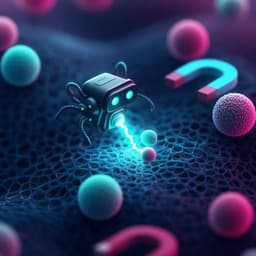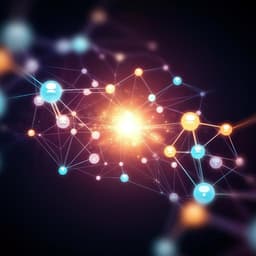Introduction
The field of active matter, focusing on the individual and collective behavior of self-propelled micro-objects (agents or motors), is rapidly expanding due to its potential applications in nanotechnology, robotics, and precision medicine. While significant advancements have been made in synthesizing and characterizing self-propelled Janus particles (particles with two distinct faces), predicting their behavior remains a challenge, particularly for anisotropic shapes. Most synthetic self-propelled particles are relatively simple in shape (spheres or rods), limiting their functionalities. However, recent progress in additive manufacturing and 3D printing allows for the creation of particles with complex geometries, such as tori. These tori, functionalized with platinum (Pt) and nickel (Ni), exhibit propulsion in hydrogen peroxide (H2O2) solutions and respond to magnetic fields. In the absence of a magnetic field, these micro-tori (7-10 µm) sediment and hover near a bottom wall, spontaneously tilting and translating parallel to the surface. They also form bound states. This study utilizes molecular simulations to elucidate the mechanisms governing the self-organization of chemically self-propelled Janus tori near walls. Previous research has examined active particle behavior near walls, observing diverse dynamics such as hovering and sliding. However, studies on more complex shapes like tori, particularly with combined chemical, hydrodynamic, and electrostatic forces, remain limited. This work specifically addresses these limitations using multiparticle collision dynamics (MPCD), a particle-based mesoscale simulation technique that accurately incorporates thermal fluctuations, hydrodynamic interactions, chemical reactions, and solid inclusions. This allows for a detailed investigation of the interplay between gravitational, hydrodynamic, chemical, electrostatic, and steric interactions in determining the behavior of these micro-tori.
Literature Review
Several studies have explored the behavior of active particles near walls, observing various dynamical behaviors. For instance, diffusiophoretically active Janus colloids near a hard wall have been shown to hover or slide along it at a constant height and tilt angle. Research also investigated more complex active agents like those constructed from linked rotating beads or swimmers with conformational dynamics. There's also existing literature on torus dynamics in bulk solutions, including studies employing analytical and numerical continuum methods for inactive tori, and investigations of active tori propelled by rotation or a diffusiophoretic mechanism. However, a comprehensive study combining all the forces (gravitational, hydrodynamic, chemical, electrostatic, and steric) influencing Janus tori near a wall within a single simulation framework, remains absent. This gap is the focus of the current research.
Methodology
The study employed multiparticle collision dynamics (MPCD), a particle-based mesoscale simulation technique, to model the dynamics of Janus tori near a wall. The simulation setup used a slab geometry with periodic boundary conditions in the x and y directions. One or more tori, constructed from linked overlapping spherical beads forming a ring, were included. These torus beads were Janus spheres with catalytic (C) and non-catalytic (N) hemispheres. The solvent consisted of A and B fluid particles, with catalytic reactions A → B occurring on the catalytic faces. A key aspect of the simulation involved the incorporation of various interaction potentials. The gravitational force (Fg) acted on the torus, causing sedimentation. Chemical reactions on the catalytic surface generated a diffusiophoretic force (Fa), propelling the torus. The direction of Fa relative to the torus orientation vector (û) determined whether the torus moved backward or forward. Electrostatic dipolar interactions between the torus and the wall were introduced by adding a charge-dipolar interaction potential to the model. This potential accounts for the electric dipole moment that the torus acquires due to electrochemical reactions, as suggested by experimental evidence (torus attracting negatively charged particles on its Pt surface and positively charged particles on its polymer surface). Steric repulsion between the torus and the wall, and between different tori, was also included using Lennard-Jones potentials. The simulation tracked the torus's center of mass distance from the wall (z), tilt angle (θ), and velocity (V). Probability distributions for these quantities were generated from numerous simulation runs. A phenomenological theory was developed to model the tilt angle probability distribution, considering the interplay of gravitational, diffusiophoretic, and charge-dipole torques. The effects of electrostatic forces were investigated by incorporating a charge-dipole interaction potential between the torus beads and the wall. Simulations were conducted for both single tori and multiple tori (two and four) to observe the formation of bound states. The MPCD simulations used a molecular dynamics time step of dt = 0.001 and a multiparticle collision time of τ = 0.5. The collision rotation angle was π/2, and grid shifting ensured Galilean invariance. System temperature, solvent density, and other parameters were carefully chosen to mimic experimental conditions and ensure accurate representation of fluid dynamics. The interaction potentials incorporated into the model included Lennard-Jones potentials for interactions between fluid particles and torus beads, a repulsive Lennard-Jones wall potential for interactions between torus beads and the wall, a charge density-dipole interaction potential, and a gravitational potential.
Key Findings
The simulations revealed a complex interplay of forces governing the dynamics of Janus tori near a wall. For a single torus, gravity and diffusiophoresis combine to create a hovering state at a certain distance from the wall. The distance from the wall is dependent on the gravitational strength parameter (g); a decrease in g leads to an increased mean distance. The inclusion of electrostatic dipolar interactions between the torus and the wall results in spontaneous tilting and horizontal translation parallel to the wall, mirroring experimental observations. The tilt angle distribution broadens as the gravitational confinement weakens. The analysis of concentration and velocity fields provides insight into the underlying mechanisms. The simulations showed distinct concentration and velocity patterns for backward and forward-moving tori, both near the wall and in the bulk. The presence of the wall significantly distorts these fields, affecting the diffusiophoretic force. Regarding multiple tori, the simulations demonstrate that backward-moving tori don't form bound states, while forward-moving tori exhibit long-lived bound states, with the structure depending on the gravitational force (g) and charge-dipole interaction strength (εcd). For two forward-moving tori, a transition from stacked to side-by-side bound states occurs as g increases, with εcd influencing the stability of these states. For four forward-moving tori, a variety of metastable bound states are observed, including those with stacked and side-by-side torus pairs, and configurations where tori exhibit flipped orientations. The phenomenological theory successfully captures the probability distribution of torus tilt angles. The analysis of the probability distributions for center of mass distance from the wall and the tilt angles shows that the behavior is a complex interplay between the gravitational forces, electrostatic dipole-wall interactions, diffusiophoretic forces and steric forces. For backward-moving tori, there was little tendency towards forming bound states. The probability distributions in this case coincide. However, forward-moving tori showed distinct behavior, forming bound states whose structures (stacked or side-by-side) are determined by the relative strength of gravitational and charge-dipole interactions. The quantitative analysis of the probability distributions for center-of-mass distance from the wall, tilt angle, and the distance between the centers of mass of the two tori reveals the details of these bound states.
Discussion
The findings address the research question by demonstrating the multifaceted nature of forces controlling the behavior of chemically propelled Janus tori near a wall. The results highlight that a complete understanding requires considering the interplay of gravity, diffusiophoresis, hydrodynamics, electrostatics, and steric interactions. No single factor is sufficient to explain the observed behavior. For example, the horizontal translation near the wall only occurs with electrostatic interactions. The observed transitions between stacked and side-by-side bound states for forward-moving tori provide insights into how seemingly simple parameter changes can drastically affect complex self-organization. The theoretical model successfully accounts for the observed tilt angle distributions, emphasizing the importance of the charge-dipole interaction in breaking the symmetry of the horizontal state. The study's significance lies in its contribution to a predictive understanding of active matter systems, particularly those with complex geometries and interactions. This improved understanding opens avenues for designing and controlling the self-organization and collective behavior of micro-robots and drug delivery systems. Future studies could involve larger numbers of tori to investigate more intricate collective behavior. Exploring different shapes of micro-objects or including magnetic interactions will also broaden our understanding of active matter dynamics.
Conclusion
This study successfully demonstrated the controlling influence of various forces (gravitational, steric-repulsive, diffusiophoretic, hydrodynamic, and electrostatic) on chemically-propelled torus colloids near walls. The simulations predict that backward-moving tori do not form bound states, while forward-moving tori exhibit a transition from stacked to side-by-side bound states depending on the gravitational strength. The existence of diverse metastable bound states for four tori suggests the potential for more complex collective behaviors in larger systems. Future research directions could involve simulations with a larger number of tori, particles of different shapes, incorporation of magnetic interactions, and exploration of the impact of different chemical reaction schemes on self-organization.
Limitations
While the simulations comprehensively incorporate several interactions, some simplifications remain. The model uses simplified Lennard-Jones potentials for steric interactions, not explicitly accounting for the detailed chemical structure of the torus surface. The charge-dipole interaction is modeled phenomenologically. Although this model is supported by experimental evidence, precise quantitative measurements are currently unavailable. The study's focus on relatively small numbers of tori limits the scope of investigations into highly complex collective behaviors observable in more extensive systems. The computational cost of the simulations restricted the exploration of a broader parameter space.
Related Publications
Explore these studies to deepen your understanding of the subject.







